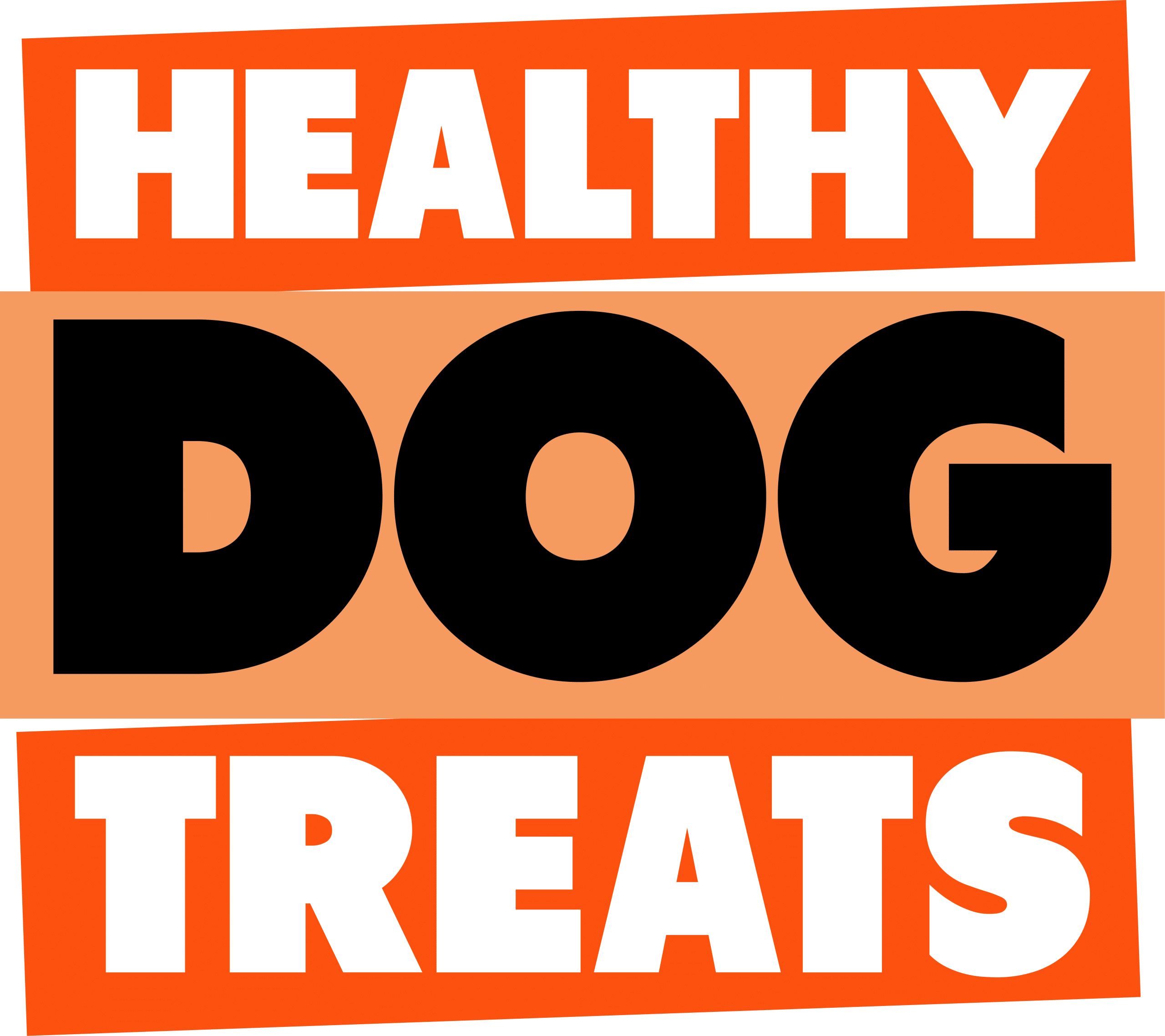The miracle of dog probiotics for gut biome health & the specific probiotics THEY need.

To say that research studies into the probiotic use for healthy and ill dogs is one of the hottest items of the last decade is an understatement. Some see it as a panacea, others a money-making machine.
But the reality is that adding the right probiotics regularly to your dogs food might be one of the most important health supplement decisions you will ever make.
- We look at what the dog gut biome is,
- Why its specifically the good bacteria in the colon that produce dramatic positive effects through the whole dog body.
- And what specific bacteria strains you need the most of in their diet.
The dilemma is that human grade probiotic capsules usually contain between 2 and 13 strains of various good bacteria, said to assist increasing these specific ones in the human gut for better digestion and general health. The other parameter you will see is populations between 2 billion and 100 billion bacteria per capsule. But since dogs are primarily carnivores, with a much higher acid stomach environment (that the bacteria must pass through unscathed), we see the value in providing capsules rather than powder form. Especially if you can hide a capsule in meat chunks rather than spreading powder over its food.
Dogs have a much shorter total intestine length than humans, so the bacteria need to do their food processing, anti-inflammatory, or immunity properties faster than that in the human omnivore intestine. Yet many of the good bacteria in human probiotics are the same strains as used for dogs! But you still need to ensure you are getting the SPECIFIC right bacteria, in the right proportions.
The incredible dog Gut Microbiome
The dog’s digestive tract mostly starts at the stomach (this has only a few bacteria), then the thin long upper intestine (much more bacteria – good and bad), and finally the lower intestine or wide colon where most of the bacterial action and health benefits from the good bacteria occurs.
The dog Microbiome is the “community” of all of the bacteria and other microorganisms in your dog’s gut – and all of the resulting complex reactions. Different genes, and environmental issues including the food you feed AND those they scavenge create a complex and UNIQUE biome, unique to your own dog! Tip the population towards the good bacteria and you tend to have a better outcome for the whole of the dog, as well as solid stools.
When a dog is sick from a virus, eating bad organic matter, stress or many other negative impacts, the bad bacteria often flourish as an unwanted side effect, potentially causing chronic diarrhea.
While a Probiotic is considered to be any live organisms that can generate positive health benefits, most commercial treatments involve adding specific good strains of bacteria to grow better than bad bacteria.
Why feed your dog probiotics?!
Your dog’s good bacteria ferment food, and especially the fibre they can’t digest. As part of their process they expel short chain fatty acids (SCFA’s) the three main types are: Acetate Butyrate , Propionate. These chemicals stay in the colon or go through the body and are vital for health and immunity. SCFA’s by themselves play vital roles such as
- Assist absorption of calcium, magnesium, iron etc – this help, plus making stools solid (when inte4stine is functioning well) is vital for nutrition upate.
- SCFA’s create T-cells in the immune system, which can stop or reduce effect of chronic inflammation – a major cause of pain.
- SCFA’s reduce food allergies effects.
NOTE – most dogs receive most of their fibre via commercial dog food, but the TYPE of fibre is vitally important to gut health. We created an article on this in 2013 and found that its all about having adequate “moderately fermentable fibre” in their kibble.
Probiotics can generally
- Improve overall gut health (better digestion, better nutrition uptake, solid stools)
- Reduce Gut pH – making environment more hospitable for growing more positive bacteria.
- Can form chemicals like Vitamin K and B. these are obviously critical to the many dog systems
- Creates serotonin– the neurotransmitter in the brain and nervous system that provides happy feelings and regulate behaviour, pain perception, appetite, body temperature etc. NOTE drugs used to treat compulsive behaviours, separation anxiety, chronic pain can deplete serotonin levels and give your dog the ‘blues’.
Support of immune system that keeps your dog healthy and resistance to viruses etc.
- SCFA’s can Build important T-cells in the immune system, which helps reduce chronic inflammation.
- Protect against food allergens
- Help the body absorb calcium, magnesium, iron and other nutrients
DOG diseases benefiting from Probiotics (the right ones).
- Pancreatitis
- Obesity
- Leaky gut/ yeast over population/ UTI’s
- Diarrhea / colitis and bowel disease.
Probiotics help improve the dog gut biome that is compromised by “A high starch diet “
“Most dogs would do well with a daily probiotic, especially dogs eating kibble or a high starch diet. However, dogs with small intestinal bacterial overgrowth or dogs with excessive gas should not take probiotics daily. “Ref 1
“Most of your dog’s bacteria are meant to live in his colon. Small Intestinal Bacterial Overgrowth (SIBO) happens when abnormally large numbers of bacteria take up residence in the small intestine. These bacteria can interfere with digestion and nutrient absorption in the small intestine. SIBO can be caused by a few factors, including: Diets that are high in sugar and carbohydrates.” Ref1
“Changes in the microbiome can make dogs sick in different ways. These changes can be caused by many things, including: High carbohydrate diet“ ref 2
If you are wondering why we have highlighted the text in these blogs about carbs, its because of the very reason we started out company – to get meat, and animal protein back into dogs, in meaningful proportions. For wild dogs, or dogs on true raw diets, this typically means 80% plus meat and offal.
This means we consider a diet high in carbs to be any diet that contains 30-40 % plant material or more. Most commercial dog food includes 60-70% plant material – this means that almost every dog on a commercial dog food diet can benefit from a regular correct probiotic ingestion. AND MORE MEAT.
If you feed a regular commercial dog food diet, even with probiotics, it suggests that single ingredient MEAT healthy dog treats are an exceptionally good idea for their overall health. That way the gut biome doesn’t have to struggle with being overloaded by carbs so much.
Dog probiotics – its vital importance, a technical explanation
“ The main activity (of probiotic bacteria) is the fermentation of alcohols and non-digestible carbohydrates (starch, inulin, cellulose, hemicellulose, pectin, and gum) (Schmitz and Suchodolski, 2016). It occurs in the colon (Bell et al., 2008) and it causes the production of gasses and SCFAs, acetate, propionate, and butyrate (60:25:15), which give energy to the intestinal epithelium and other tissues (Wong et al., 2006).
SCFAs synthesis leads to a reduction of intestinal pH value, which is the first sensory line of defense and it supports growth, proliferation, and differentiation of epithelial intestinal cells. Commensal bacteria defend the host from pathogens, producing bacteriocins and colicins and competing for nutrients and ecological benefits (Liévin-Le Moal and Servin, 2006). Moreover, when SCFAs are absorbed through the intestine, they allow the re-absorption of Na+ or K+ ions (Fleming et al., 1991).” Ref 5
At the moment you might be astounded at the miracle function of a ‘few strains of bacteria’ doing most of this work. But this is the tricky part, research into identifying the right types of bacteria and right amounts – and how effective they are.
Many articles keep coming back to Five critical good gut bacteria for dogs: Lactobacillus acidophilus, Lactobacillus casei, Bifidobacterium breve, Enterococcus faecium, Bifidobacterium lactis. Ref 2
But these come from several different sources and serve different health functions. And just as important, DIFFERENT areas of the dog’s digestive tract have different proportions of bacteria populations.
The dog digestive tract
To understand what part of the dog’s digestion probiotics should target, its good to refresh the different parts of the dog digestive tract.

The Bacteria found in different dog tract sections in HEALTHY DOG Ref 4
| Dog digestive tract section | Bacteria typically found |
| Stomach | total bacterial load is comparably low. The vast majority are Proteobacteria (99.6%) with only few Firmicutes (0.3%) |
| duodenal | of six primary phyla: Firmicutes (46.4% of obtained 16S rRNA gene sequences), Proteobacteria (26.6%), Bacteroidetes (11.2%), Spirochaetes (10.3%) Fusobacteria (3.6%) and Actinobacteria (1%) |
| jejunum | Proteobacteria as the most abundant (46%), followed by Firmicutes (15%), Actinobacteria (11.2), Spirochaetes (14.2), Bacteroidetes (6.2%) and Fusobacteria (5.4%) |
| Duodenal | contained 22% and 10% of Lactobacillales + four other phyla Tenericutes, Cyanobacteria, Verrucomicrobia and Chloroflex, which were all present in low frequency |
| ileal | predominantly contained Fusobacteria, Firmicutes and Bacteroidetes. much lower proportions of Lactobacillus spp. (1.4%). |
| Colon | co-dominant phyla of Fusobacteria, Bacteroidetes and Firmicutes (around 30% each) in healthy dogs. |
While research is ongoing, it is thought currently that as the colon does much of the processing of food (extracting nutrients) – that if “Fusobacteria, Bacteroidetes and Firmicutes” are the main bacteria groups in a healthy dogs colon (approx. 30% each – see graph below) , that these are the kinds of bacteria that should be added in probiotics of dogs to get them healthy again, or keep them healthy.
“In IBD dogs, Minamoto et al. (2014) have highlighted an increase of Gammaproteobacteria (BAD bacteria) and a decrease of Erysipelotrichia, Clostridia, and Bacteroidia (good bacteria), using 454-pyrosequencing on fecal samples.” Ref 5
These are the five ‘friendly’ bacteria that most sites claim to live In the dogs intestine, and what they need more of in the form of probiotic capsules
- Lactobacillus acidophilus (phyla Firmicutes )
- Lactobacillus casei (phyla Firmicutes)
- Bifidobacterium breve (phyla Actinobacteria)
- Bifidobacterium lactis (phyla Actinobacteria)
- Enterococcus faecium (phyla Firmicutes )
Examples of ‘preferred’ dog probiotics by various dog expert sources:
Dogsnautrally magazine suggests: Lactobacillus Acidophilus, Lactobacillus Casei, Lactobacillus Plantarum And Lactobacillus Rhamnosus, Bifidobacterium Animalis, Bifidobacterium Longum, Enterococcus Faecium, Pediococcus Acidilactici
Iloveveterinary: Lactobacillus casei , Lactobacillus acidophilus, Bifidobacterium breve, Enterococcus faecium, Bifidobacterium lacti
Holistapet: L. Acidophilus, L. Casei:, L. Plantarum and Lactobacillus Rhamnosus: , L. Plantarum and Lactobacillus Rhamnosus: B. Longum:, Enterococcus Faecium, Pediococcus acidilactici:
Remembering that L and B types lat 24 hours in the gut leaving on some dna.
Proportion of main Phyla bacteria groups found in three of the main dog digestive sections
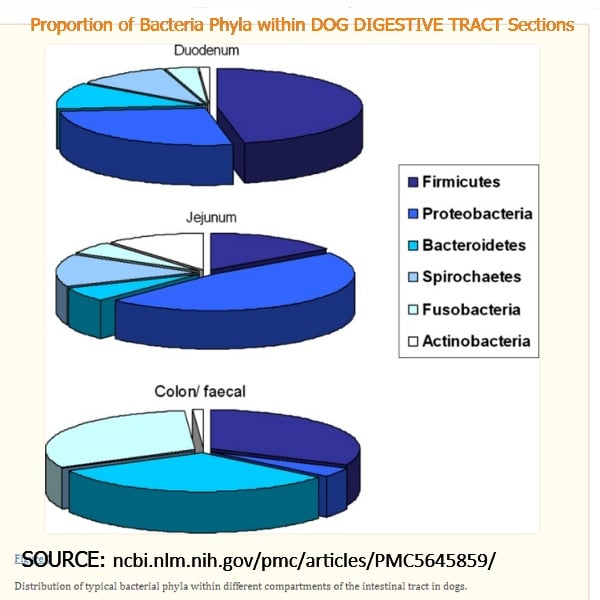
What is the bacteria grouping (NAMING methods) of major types in the dog intestine.
On product labels, probiotics will be identified by strain names and species name. Bifidobacterium and Lactobacillus species (or major strain groups) are often shown abbreviated as B. Or L. Hence strain names AND species names you might see are : B. Longum or L. acidophilus.
It is noted that while Lactobacillus and Bifidobacterium probiotics are two of the main probiotics used to help dogs with diarrhea issues, these bacteria are considered fragile and struggle to colonise in the colon, and so typically last about 24 hours before they’re eliminated from the gut. Hence if a dog is having acute loose stools, these probiotics need to be added daily.
| GROUP (PHYLA) | HOW MADE | Main Specific DOG ‘good’ bacteria |
| Lactobacillus = Lactic Acid Probiotics FUNCTION =
inhibits the growth of harmful bacteria |
From fermented milk convert milk sugar to lactic acid, which | Lactobacillus Acidophilus – reduce the populations of harmful clostridia.
Lactobacillus Casei – lives in the mucus membrane of animals. It’s an important part of the gut-brain axis and can affect mood and emotions. Lactobacillus Plantarum and Lactobacillus Rhamnosus – build healthy colon walls in dogs with IBS and can decrease antibiotic-related diarrhea |
| Bifidobacterium
FUNCTION = interact with immune cells |
Produced by lactic acid but not considered a lactic acid bacterium | Bifidobacterium Animalis managing acute diarrhea in dogs.
Bifidobacterium Longum – gut-brain axis. |
| Enterococcus – MORE long lasting than Lactobacillus and Bifidobacterium | lactic acid bacteria that inhibit the growth of harmful bacteria in the gut | Enterococcus Faecium |
| Pediococcus | lactic acid bacteria | Pediococcus Acidilactici – manage skin conditions and leaky guts. |
The specific COLON microbiota bacteria required for a healthy dog
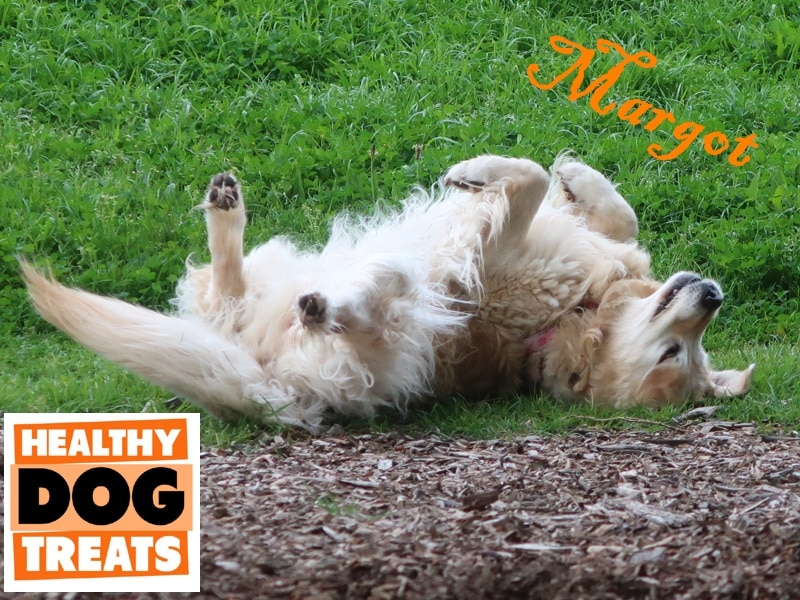
energy needs, metabolism, immunological activity, and neuro-behavioural development. We know that this eco-system is comprised of : Bacteria, archaea, fungi, protozoa, and viruses.
So why do pharmacy companies focus mostly on the ‘good’ bacteria? Seemingly because it compromises the majority of the heavy lifting of the gut biome. The most action, and the best way of crowding out the bad bacteria (probiotics add to good bacteria and over-crowd bad, rather than antibiotics that can kill both good and bad).
The good “bacteria have a fundamental role on the induction, shaping, and function of the host DOG’S immune system, which in turn is important in the development of the physiological gut structure and the identification of pathogens from commensal bacteria. This relationship allows the defensive responses against pathogens being effective and it regulates the pathways involved in the tolerance of innocuous antigens.” Ref 5
If you use antibiotics, it often kills off much of the good and bad bacteria indiscriminately. Leaving a dog’s immunity low. Probiotics just overwhelm the enemy by numbers.
To give you an understanding of the scale of this microbiota, of all of the different body sites in dogs where microorganisms live “ gut microbiota is the largest one. It is composed by 10 to the power 14 cells. That is the number ten with the 14 Zeros after it. It has more than 1,000 bacteria species in the gut, and its genome is 150 times larger than most of animals’ genome.” ref 5
Back in 2002, the researchers knew that the pH value and residence-time of bacteria highly regulated the concentration of bacteria in different GI tracts – and that the Bowel / Colon was very important for a dog’s overall health.
Early research using “ 16S rRNA gene sequencing “ techniques, showed that “ 90% of bacteria belong to two phyla: Bacteroidetes and Firmicutes”
This was later amended to the 2019 research mentioned previously that suggested that the dogs colon is 90% made up of “Fusobacteria, Bacteroidetes and Firmicutes” (around 30% each). “The phylum Firmicutes includes Clostridium clusters, which include Ruminococcus spp., Faecali bacterium spp., and Dorea spp.
These bacteria, Bacteroidetes and Actinobacteria can produce short-chain fatty acids (SCFAs), the essential energy source for colonocytes. Moreover, they help to maintain the epithelial barrier by strengthening tight junctions, to regulate intestinal motility and to stimulate the production of anti-inflammatory compounds.” Ref 5
“Changes in gut-microbiome are associated with diseases, including inflammation, obesity, metabolic syndromes, and mood disorders. A balanced microbial ecosystem is crucial for host health and homeostasis” ref 5 (2017 research)
“ The interaction between gut microbiota, its host, and other somatic cells regulates many functions, such as digestion, host metabolism, vitamins synthesis (vit. K and complex B), biotransformation of bile acids, xenobiotics metabolism, correct maturation of gastrointestinal cells, and defence against pathogenic bacteria (Steiner and Ruaux, 2008). Therefore, the microbiota can be defined as a metabolically active “organ.” ” Ref 5
“ Genetic diversity of microbiota in the gut guarantees the presence of many enzymes and biochemical pathways that otherwise the host does not possess.” Ref 5
Unlike Probiotics (specific good bacteria often digested in capsule form that is coated so it reaches the colon (through the high acid stomach section) .. PREBIOTICS are a new thing in dog treatments. This is a definition of it: “Prebiotics, are “a non-digestible compound that, through its metabolization by microorganisms in the gut, modulates composition and/or activity of the gut microbiota, thus conferring a beneficial physiological effect on the host” (Bindels et al., 2015).”
For completeness we can also inform you that there are “Prebiotic Foods” that can be safely fed to dogs. Again we recommend you research the dose levels, and don’t sacrifice your meat content too much (energy allowance). The foods below are high in fibre are suggested as the safest ones to feed the beneficial bacteria populations (via probiotics you feed) and support a healthy gut.
These foods include: Asparagus, Bananas, Mushrooms, Chicory root, Dandelion greens, Garlic (small doses), Jerusalem artichoke Ref 1
Why MUCH more research is required in dog gut biome and probiotics.
We have mentioned several times in this analysis that dog gut biome research is very much in the early days, very complex, can involve thousands of bacteria interactions with the host and other microorganisms and EVERY dog has a UNIQUE gut biome (ie optimum mix of good bacteria, to remain in optimum health).
Given this information you can see how using a few basic probiotics with every dog is more of a shot gun approach rather than targeted, engineered science. But even if they got just the three main ones for the colon, health could dramatically improve.
And here is a surprise a 2021 report on “gut microbial composition in healthy dogs, divided them into groups according to their breed, age, or body condition score. From (their) results, age is the most crucial factor driving the gut microbial community of dogs compared to breed and body condition score (especially Fusobacterium perfoetens, which was much more abundant in the older group).” Ref 6
How does gut microbiome bacteria vary between dogs?
The recent study analysed Fresh faecal samples from 96 healthy dogs by sequencing the V3-V4 region of the 16S rRNA gene. This composition would be closest to the communities of the dogs colons.
The major microbial phyla were Firmicutes, Bacteroidetes, Fusobacteria, Proteobacteria, and Actinobacteria.
In the comparison by breeds, relative abundance of Fusobacterium was significantly differed. Interestingly, Fusobacterium perfoetens abundance was positively correlated with age. Moreover, despite the healthy appearance of dogs in all age (0.5–10 years) and BCS (3–6) groups, the gut microbial environment may be disadvantageous in older dogs or in dogs with an abnormal BCS.” Ref 6
RESULTS GM of 96 Healthy Dogs: “from dogs of nine breeds, aged 0.5 to 10 years and with a BCS of 3 to 8. A total of 1254 bacterial OTUs classified into 14 phyla, 27 classes, 56 orders, 106 families, 286 genera, and 533 species were obtained.“ Ref 6
98% of total bacteria types in the dogs ( colon ) were on average found to be these FIVE bacteria groups with these proportions: Firmicutes (44.8%), Bacteroidetes (27.7%), Fusobacteria (14.2%), Proteobacteria (8.8%), and Actinobacteria (3.4% of total average abundance)
Overall gut microbial composition of 96 healthy dogs. Relative abundances of (a) phyla (≥0.01% of the total sequences)
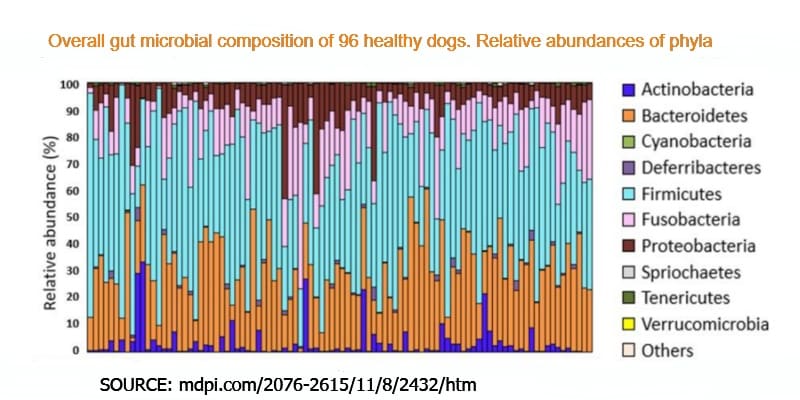
Overall gut microbial composition of 96 healthy dogs. Relative abundances of genera (≥1% of the total sequences) from the five major phyla.
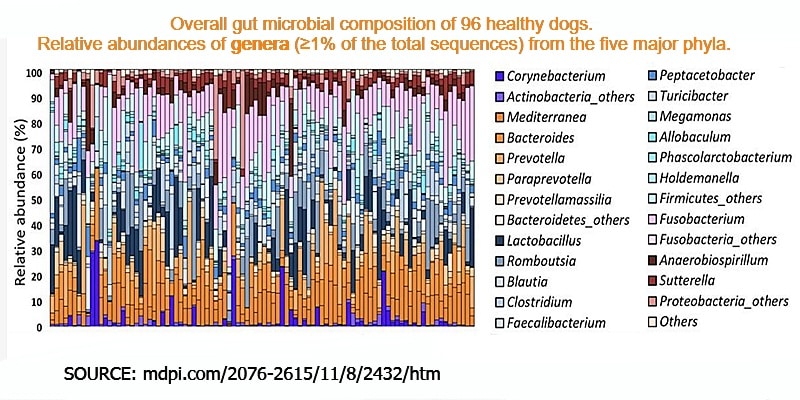
BREED SPECIFIC Gut bacteria
These were the NINE dog breeds included in the study: Bichon, bulldog, chihuahua, dachshund, greyhound*, Maltese, Pomeranian, poodle, Yorkshire terrier. Noting that with only 2 greyhounds they were not included in the statistical analysis as too small a sample.
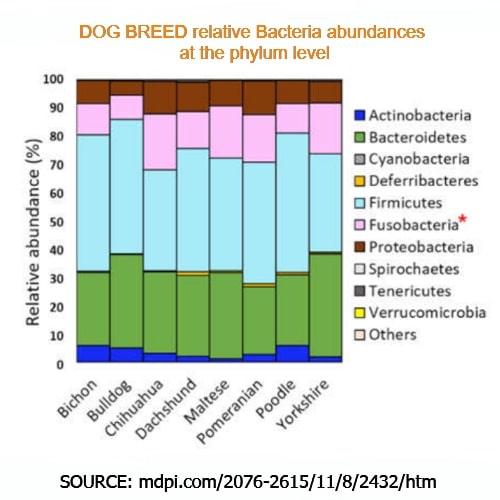
An example of difference between breeds – poodle and Maltese. The results between the Maltese and Poodle groups (highest sample numbers) showed that the abundance distribution of taxa … In Malteses, Fusobacteria were abundant, whereas in Poodles, Firmicutes and Actinobacteria were abundant. … Moreover, there were significant differences in the abundance of four phyla and sixteen species between these two breeds . Ref 6
Relative abundances of bacteria at the phylum, genus, and species levels by the age of dogs.
In the chart below: Major bacterial groups were selected for chart analysis (phylum ≥ 0.01%, genus ≥ 2%, and species ≥ 3% of total abundance). * Indicates that significantly different bacteria group. Ref 6 has a lot of great data to substantiate the real world proportions of specific bacteria.
The graph for AGE related feaces (ie colon bacteria ) based on three different dog age groups shows the SPECIFIC bacteria found in healthy dog colons – and so the major ones you would want to add to your dog in the form of probiotics 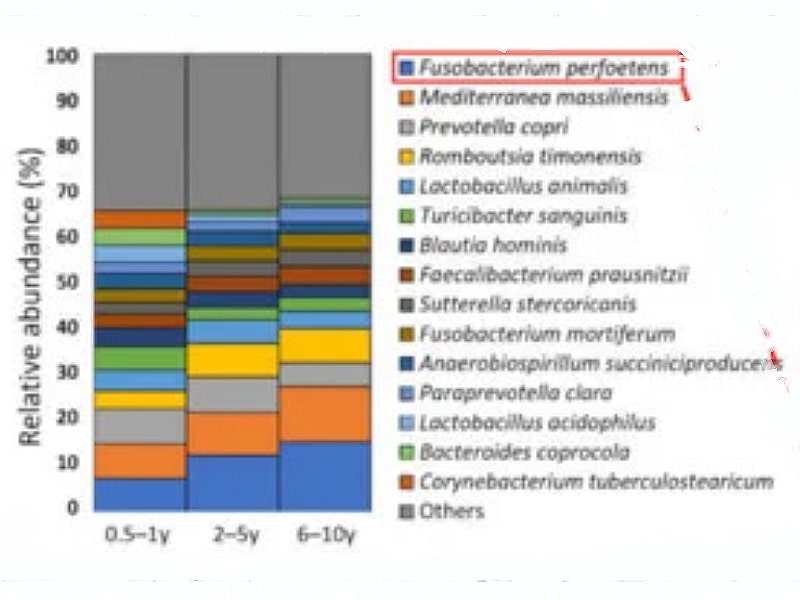
Looking at the above chart, we analysed the top 14 specific bacteria (that made up over 3% of population) in dogs colons (age 6-10 years), and produced the following table. Removing the 30% of bacteria that are under 3% of the population from the calculations, we calculated the Percentage that each of the 14 species of bacteria make up of the total 14.
We then created a column next to these bacteria for the phyla that they are in. In this specific experiment they found the phyla groupings for the top four phyla (of all bacteria species) were: Firmicutes followed by: Bacteroidetes , Fusobacteriota and Proteobacteria.
As you can see from the table below. The major bacteria species, phyla does tend to fall into these FOUR major phyla groups for a dogs colon.
If getting dog or human probiotics, this suggests that to help boost the specific bacteria most common in a healthy dogs colon, that the getting these specific bacteria, in close to this order (if possible) might be the closest thing you an do to helping keep these good bacteria alive and healthy in your dogs colon.
| NUM | % | SPECIES | Phyla |
| 1 | 22.9 | fusobacterium perfoetens | Fusobacteria |
| 2 | 18.5 | mediterranea massiliensis | Bacteroidetes |
| 3 | 11.4 | romboutsia timonensis | Firmicutes |
| 4 | 7.4 | Prevotella copri | Bacteroidetes |
| 5 | 6.1 | lactobacillus animalis | Firmicutes |
| 6 | 5.4 | faecalibacterium prausnitzii | Firmicutes |
| 7 | 5.1 | fusobacterium mortiferum | Fusobacteriota |
| 8 | 5.1 | sutterella stercoricanis | Proteobacteria |
| 9 | 4.0 | blautia hominis | Firmicutes |
| 10 | 4.0 | Turicibacter sanguinis | Firmicutes |
| 11 | 3.4 | lactobacillus acidophilus | Bacillota |
| 12 | 2.7 | anaerobiospirillum succiniciproducens | Proteobacteria |
| 13 | 2.0 | bacteroides coprocola | Bacteroidota |
| 14 | 2.0 | paraprevotella clara | Bacteroidota |
CONCLUSIONS
It is still very early days into understanding the healthy or sick dogs Gut Microbiota good and bad bacteria levels.
But we know that gut bacteria and other good biome microorganisms are INCREDIBLY important in maintain the health (immunity, happiness, arthritis propensity, stool firmness, structure of the colon walls for extracting nutrients etc) of dogs.
Original studies suggested that the different parts of the digestive system, from stomach through many sections to the colon, have VERY different bacterial types and proportions. They suggest that on average Fusobacteria, Bacteroidetes and Firmicutes comprised up to 90% of the whole colon biome.
But analysis has shown that the dog gut biome, and colon, usually contain well over 1000 good bacteria, often with synergetic in effect. This makes one question while some bacteria are known to be super good at for instance correcting an issue like acute diarrhea, why you wouldn’t include a full spread of good bacteria that are more likely to cover the many facets of health that the dog gut biome are responsible for?
The likely reason we see a maximum of 20 good bacteria in probiotics is simply cost. It is likely that the expense of synthesizing each specific strain and combining in the right proportions would lead to a very expensive product– hence why even human probiotic capsules tend to have a maximum of 13 strains, many probiotic brands have much less.
The 2021 study involving 9 breeds was particularly instructive into the possible differences in biomes at breed level. It showed that while there were signification proportional differences between breeds (and even ages ) of dogs, that the four main bacteria they measured in stools (and therefore most likely in colons were:
- Firmicutes
- Bacteriodetes
- Fusobacteria
- Proteobacteria
NOTE these are the MAJOR PHYLA or the top grouping or STRAIN names of the good GM bacteria (not the specific bacteria). Though the second breed bacteria graph does give an indication of specific bacteria proportions at breed level too.
These results correlate very well with the results shown in the https://www.ncbi.nlm.nih.gov/pmc/articles/PMC5645859/ Study.
The bar charts of the 96 individual dogs shows how much variance there is between dogs even in the same breed. But also the commonality in the base bacteria.
we also calculated the approximate percentages of the top 14 specific bacteria (out of the 70% that these 14 make up in a healthy dogs colon) . getting these specific bacteria in a probiotic could be the best probiotic solution.
How to use this information with your dog
At the start of this article, we looked at what specific bacteria three individual dog blogs suggest are important for dogs. Mostly they had the same ones in common.
We then see that most dog’s colons comprise 90% of good bacteria from just three Phyla (that most of the blog examples also come from.
This suggests if you are buying commercial dog brand probiotics (typically in powder form) or human grade probiotics (often in capsule form) – that you would want to have as many of the good bacteria that are found in high levels in most dog’s colon, in the proportions of the biggest populations in healthy dog colons.
My real world example
This is what I have done for my own dog, with good measure of success for acute long lasting diarrhea solution. My spoodle is over 14 (in 2022) and has had hayfever and a sensitive stomach since young. Daily Omega 3 from salmon oil has resolved much of his skin and ear infection issues but as he has aged, he has lost some ability to process raw meat (enzyme loss in gut).
He can still very successfully eat his night time meal = half raw red meat (low fat beef ) or cooked chicken, or canned fish, and quality dog roll (mostly for its fibre and high vitamin content). But when he walks off lead in dog parks he has a tendency to eat organic things he shouldn’t and drink dirty water that causes loose stools again.
If the bad bacteria load is too high, he has needed vet prescribed anti-biotic courses, but for general wellbeing I have found that giving him a 10 strain, 50 billion probiotic capsule for humans, typically treats his very loose stools within half a day. I made sure that the THREE main bacteria required for dog colons are in this formula!
What the probiotic is doing is ensuring that he gest a sufficient amount (particularly for an older dog) – and half of the probiotic specific bacteria specifically add the right bacteria typically found in all dogs’ colons. The other probiotics are a BONUS adding to the vast diversity of bacteria he has in his gut.
Even more exciting for the future (or well-heeled people now) is the thought that you could actually get your dog’s stools tested, when they are healthy, and get a blend of probiotics that mimics the proportions specific to their GM biome.
THAT would be (besides meat-based treats) one of the healthiest regular nutritional supplements that you could every find for your dog, that can reduce the proportion of carb load that adversely affects the good bacteria populations in the colon.
A word on dosage levels. Since much of dog brand probiotics are in powder form, we usually read 1 to 3 teaspoons of powder depending on dog size. The fact is, that side effects from probiotics are very rare, and the possibility of ‘overdoses’ is low. Just ensure that if you use a human brand, that the capsules contain the dog specific strains we have mentioned (preferably at least 4 of the 5) and the more extra strains after that are fine too.
Human probiotics usually come in 2 billion to 100 billion capsules. probioticsfordogs site says “1 – 4 billion Colony Forming Units. (CFU)”, is acceptable. Though we have used 10-20 billion human capsules (with the right dog specific good bacteria) and Archie’s stools are the best they have ever been! They suggest feeding the capsule at mealtimes.
“For a pet with IBS, a much higher CFU count is more effective. For dogs with diarrhea, a standard or lower CFU of probiotics is in order. ” Ref 7 – Though this seems to contradict why many people use probiotics, as they are supposed to actually help prevent diarrhea, by the bacteria properly processing the food and fibre.
Ref 7 also says “Dogs who are sensitive or immune-compromised may have a reaction after the initial dosage of probiotics during the adjustment phase. While reactions are rare, they can include gas or loose stools.” ref 7 NOTING that gas and loose stools can often be a function of a commercial dog food having the wrong type of fibre – not the moderately fermentable type such as beet pulp. If the fibre ferments too much, they can get gas, too little and the bacteria starve and stools can turn to liquid.
The main consideration I would have with larger dose probiotics is not causing small intestinal bacterial overgrowth (SIBO). A condition of the small intestine resulting in increased numbers of bowel bacteria (more common in German Shepherds). The high bacteria count in the small intestine can cause damage to the absorptive surface of the upper intestine, before food reaches the colon. “Malabsorption and SIBO both result in diarrhea, similar to that associated with enteritis. However, with bacterial overgrowth the diarrhea is chronic in nature, often lasting weeks or months.” (vcahospitals)
If your dog changes behavior or is in any pain after beginning probiotics, consider reducing the amount, or administering with a day break in between – consulting a vet if the issue persists.
NOTE, while this research and my comments are as accurate as possible, probiotics are not meant to heal all sick dogs, or all dog illnesses. If you are considering giving regular dog pro-biotics, please consult your vet.
APPENDIX
How does dog probiotic blends compare with human commercial probiotics
NOTE almost ALL dog commercial probiotics come in loose powder form and you measure it into their meals in scoops. The below table is just for comparison of dog specific and Human probiotic blends – NOT a recommendation.
| DOG probiotic GENERAL SUGGESTED by blogs | BIG DOG Probiotics For Dogs
20 billion per 5g scoop |
Webber naturals (HUMAN) 5 strain, 5 billion caps | NOW Foods, (HUMAN Probiotic) -10 strain , 25 Billion, in capsules |
| Lactobacillus acidophilus
Lactobacillus casei
Bifidobacterium breve
Bifidobacterium lactis
Enterococcus faecium
|
Bacillus subtilis
Enterococcus faecium, Lactobacillus acidophilus, Bifidobacterium longum Bifidobacterium thermophilum Saccharomyces cerevisiae
Digestive Enzymes: Alpha-amylase, Protease, Cellulase, Lipase, Pectinase
|
Lactobacillus casei (30%)
Lactobacillus rhamnosus (25%) Lactobacillus acidophilus (15%) Bifidobacterium longum(15%) Bifidobacterium breve (15%) |
Lactobacillus acidophilus (La-14), Firmicutes phylum
Bifidobacterium lactis (BI-04), L Actinobacteria phylum actobacillus plantarum (Lp-115), Firmicutes phylum Lactobacillus casei (Lc-11), Firmicutes phylum Lactobacillus rhamnosus (Lr 32), Firmicutes phylum Lactobacillus paracasei (Lpc-37), Bacillota phylum Bifidobacterium breve (Bb-03), Actinomycetota phylum Streptococcus thermophilus (St-21), Firmicutes phylum Lactobacillus salivarius (Ls-33), Firmicutes phylum Bifidobacterium longum (BI-05) Actinobacteria phylum |
Summary of the studies on the effect of BACTERIA (probiotics) treatment. Ref 5
| Disease | Probiotic treatment | Effect of treatment | References |
| Chronic enteropathies | Administration of mixture of probiotic bacteria: Lactobacillus spp. (two Lactobacillus acidophilus strains (NCC2628, NCC2766), one Lactobacillus johnsonii strain (NCC2767) | Beneficial effects on cytokine expression mainly through regulatory T-cells | Sauter et al., 2005 |
| IBD | Administration of VSL#3 | Significant decrease in clinical and histological scores and decrease in CD3+ T-cell infiltration. | Rossi et al., 2014 |
Studies of prebiotic FOOD treatment in dog. Ref 5
| Prebiotic treatment | Effect of treatment | References |
| Dry diets, one supplemented with 3% chicory (1.5% inulin) | Reduction of fecal pH and increase Bifidobacteria population | Zentek et al., 2003 |
| diet with 7.5% beet pulp (60% total dietary fiber, ~4:1 insoluble: soluble fiber) | Increase the density of Firmicutes and decrease that of Fusobacteria | Middelbos et al., 2010 |
| Diet with the supplement of FOS | Growth of Bifidobacteria | Pinna et al., 2018 |
References
Ref 1 Probiotics For Dogs: The Ultimate Guide , dogsnaturallymagazine by Dana Scott 2022-09-14
Ref 2 Foods With Probiotics for Dogs. Reviewed by Vanessa Farner, DVM on July 01, 2021
Ref 3 Understanding the canine intestinal microbiota and its modification by pro-, pre- and synbiotics – what is the evidence? Silke Schmitz,Jan Suchodolski First published: 11 January 2016
Ref 4 Dog digestive tract https://veteriankey.com/digestive-system/
Ref 5 Role of gut microbiota in dog and cat’s health and diseases , Elisabetta Mondo*, Giovanna Marliani, et al . Department of Veterinary Medical Sciences, University of Bologna, Bologna, Italy Published: 01/09/2019
Ref 6 Comparison of Gut Microbiota of 96 Healthy Dogs by Individual Traits: Breed, Age, and Body Condition Score by Inhwan You , Min Jung Kim, Animals 2021,
Ref 7 Understanding CFU & Dosage, probioticsfordogs site.

